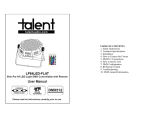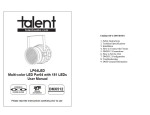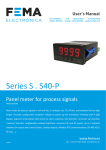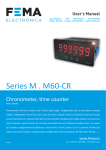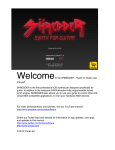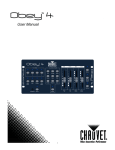Download Talent LP64LED-FLAT Slim PAR 64 DMX Light
Transcript
Notes 10. DMX General Information The DMX512 digital communication protocol was introduced to control stage lighting and special effects. The DMX standard features 512 available channels, and they are assignable in any sequence that conforms to the user's needs. Each DMXcapable fixture requires one or more sequential channels. A starting address, which indicates the first control channel reserved for that particular fixture, must be assigned to the fixture before the controller can recognize it. DMX controllable fixtures may vary in the number of channels they require, depending on the fixtures features and/or functionality. Channels should never be permitted to overlap; otherwise, for example, a fader that controls blue output on one fixture may cause strobing or dimming on an adjacent, incorrectly assigned fixture. Multiple fixtures of the same type that use an identical starting address will function in unison. Fixtures assigned properly spaced starting addresses will operate individually, but a DMX controller with sufficient channels can be configured to run these same fixtures either combined or independently. The sequence in which DMX fixtures are connected has no effect on how a controller communicates with each individual lighting fixture. Although 3-pin XLR mic cables may be used to connect DMX fixtures over short runs, longer distances will introduce data errors due to the mic cable's incorrect impedance. For best results, Talent Sound & Lighting recommends the use of correct 120 ohm, low-capacitance, twisted pair cable designed for the DMX512 protocol. It is also suggested that a termination resistor plug be used on the output connector of the last fixture in an array of DMX instruments. This resistance ensures proper data transmission. TABLE OF CONTENTS 1. Safety Instructions 2. Technical Specifications 3. Installation 4. How to Connect the Fixture 5. DMX512 Connections 6. How to Set the Unit 7. DMX Configuration 8. IR Remote Control 9. Troubleshooting 10. DMX General Information 1. Safety Instructions 9. Troubleshooting • Please keep this User Manual for future consultation. If you sell the fixture, be sure to include this instruction booklet to ensure proper maintenance and use. • Unpack and check carefully for transportation damage before using the fixture. • Before operating, ensure that the power supply voltage and frequency match the power of your electrical system. • It's important to connect the yellow/green conductor to ground to avoid electric shock. • Disconnect main power before servicing and maintenance. • Use a safety cable when permanently mounting this fixture. Always handle the fixture with care. • Maximum ambient temperature is 104° F. • In the event of a serious operating problem, stop using the fixture immediately. Please contact the dealer from whom you purchased the fixture, the nearest authorized technical repair facility, or Talent Sound & Lighting directly. • Do not connect the device to any dimmer pack. • Do not touch exposed wires during use, as there might be a hazard of electrical shock. • To prevent or reduce the risk of electrical shock or fire, do not expose the fixture to rain or moisture. • The fixture must be replaced if there is visible damage to the housing. • Do not look directly at the LED light beam while the fixture is on. Here are some troubleshooting suggestions: Warning: Please read the instructions carefully. They include important information about installation, operation, and maintenance. Do not connect more than 32 units in series (daisy-chaining) on a single power circuit. D. The fixture doesn't respond to sound. 1.) Make sure the fixture is not set to receive a DMX signal. 2.) Check the fixture's internal microphone by tapping the microphone. Caution: There are no user serviceable parts inside the fixture. Do not open the housing or attempt any repairs yourself. In the unlikely situation your unit may require service, please contact your dealer or Talent Sound & Lighting. A. The fixture does not work, there is no light output. 1.) Check the connection of power and main fuse. 2.) Measure the voltage output on your power receptacle to ensure proper voltage. B. Fixture does not respond to DMX control. 1.) DMX LED should be on. If not, check DMX connectors and cables for proper connection. 2.) If DMX LED is on but not responding to a channel, check the DMX address settings and DMX polarity. 3.) If you have intermittent DMX signal problems, check the pins on the cable connectors and on the fixture. 4.) Try to use a different DMX controller. 5.) Interference may occur if DMX cables are run alongside high voltage cables. C. Fixture responds erratically to DMX control. 1.) You may have a break in the DMX cabling. Check the LED for the response of the master/ slave mode signal. 2.) Wrong DMX address in the fixture. Set the fixture to the proper address. 3.) Use of microphone cables for DMX connections can cause errors 8.2 IR Remote Control Functions 2. Technical Specifications (1) Auto (2) Sound (3) DMX Auto show Sound active DMX512 control, switch mode between address and channel. (4) Black Out Acts as a shutoff button when activated. (5) Red Red LEDs on (6) Green Green LEDs on (7) Blue Blue LEDs on (8) White Red, Green, and Blue LEDs are turned on (9) Increase parameters (10) Reduce parameters (11) 0~9 In DMX mode, the 0 through 9 buttons set DMX addresses on the fixture. When DMX is first selected, the 0~9 buttons change the address. Pressing the DMX button again allows you to change the channel mode. In Color mode, the 0~9 buttons can be used to input values directly to select custom colors. (12) Jump Jump color change mode (13) Fade Gradual change mode (14) Color Color mode, static colors ranging from 0 (off) to 255. If the program is not in Color mode, and you want to select a custom color, you must first press the Color button. Use numbered 0~9 buttons to manually input a value, and/or buttons (+) and (-) to adjust selection. As a general guideline, C042 = green; C126 = red; and C210 = blue. Values above, below, and between these values will be gradual mixtures of red, green, and blue, accordingly. (15) Flash Only in Auto, Fade, Jump, and COLOR modes. Press once for strobe mode, press again to return to the previous program. Note: Please make sure there is nothing between the remote controller and the fixture. Maximum distance for the remote to work is 10 meters. • DMX channels: 3/5/7 selectable via digital display • 181 Ultra Bright 10 mm LEDs (Red: 49, Green: 72, Blue: 60) • 125 Static Colors/Dimmer/Strobe/Fade/Jump • Auto, sound active, DMX, and master/slave modes • Internal programs with sound activation • 3-pin XLR in/out sockets for DMX control • RGB color mixing • Beam angle: ±20° • Power consumption: 20 watts Power input: AC 90V-250V, 50-60 Hz • Dimension: 10.83" diameter x 4.13" deep • Weight: 3.52 lbs. 3. Installation 8. IR Remote Control The unit should be mounted via its screw holes on its bracket. Always ensure that the unit is installed to avoid vibration while operating. Always ensure that the structure to which you are attaching the unit is secure and is able to support a weight of 10x this fixture's weight (35.2 lbs.) Always use a safety cable that can hold 12x the weight of the fixture. 4. How to Connect the Fixture 3-Pin and 5-Pin XLR DMX Connectors: Some manufactures use 5-pin XLR connectors for data transmission in place of 3-pin. 5-pin XLR fixtures may be implemented in a 3-pin XLR DMX line. When inserting standard 5-pin XLR connectors into a 3-pin line, a cable adapter must be used. The chart below details the correct cable conversion. 8.1 IR Remote Control Keypad 7. DMX512 Configuration DMX Channel Values (3-Channel Mode) DMX Channel Values (5-Channel Mode) 5. DMX512 Connections DMX512 is a widely used protocol for intelligent lighting control, with 512 available channels. Even if you do not wish to operate your Talent lighting fixture via an outboard DMX controller, utilizing the master/slave mode will still require unit-to-unit connection by proper DMX cables. Caution: Common microphone cables may be used to connect small numbers of DMX fixtures over short distances, but offer the risk of erratic operation. Use of correct DMX cables greatly reduces data errors caused by improper connection. DMX Channel Values (7 Channel Mode) • If you are using a controller with 5-pin DMX output, use a 5-pin to 3-pin adapter cable. • Connect fixtures together in a "daisy chain" by connecting the DMX output of the first fixture to the DMX input of the next fixture. This cable cannot be branched or split by a "Y" cable. Inadequate or damaged cables, bad solder joints, or corroded connectors can easily distort the signal, cause errors, and shut down the system. Never allow contact between the data common/shield connection (XLR Pin 1) and the fixture's chassis/electrical ground. • The DMX output and input connectors are pass-through to maintain the DMX circuit if power to one of the units is disconnected. • On the last fixture, the DMX output should be terminated with a terminator to reduce signal errors. Solder a 120 ohm 1/4 watt resistor between pin 2 (DMX-) and pin 3 (DMX+) on a 3-pin XLR plug and connect it to the DMX output of the last fixture. For additional details about DMX operation, please review Section 10. 6. How to Set the Unit 6.1 Control Panel Your Talent Sound & Lighting fixture may be operated as a stand-alone device that runs on pre-programmed routines or sound activation, in master/slave mode with other devices, or via an external DMX512 controller. In DMX mode it is configurable to be controlled by 3, 5, or 7 channels. Besides stand-alone operation, there are two main ways to control the fixture: A. Universal DMX control mode B. Master/Slave operation 6.2 Main Function A. Universal DMX controller This fixture's DMX address can be set remotely by a universal DMX controller. First, you need to program two scenes into a chase, and then link the fixtures to the universal DMX controller. When you run the chase, the fixtures in the chain will set the series DMX address automatically. Each lighting fixture needs to have an address set when in DMX mode, to receive the data sent by the controller. The address number is between 0511 (usually 0 & 1 are equal to 1). Please refer to the following diagram to set the address for the first four units. The numbers 1, 5, 9, and 13 indicate the starting address of each of the fixtures. B. Master/Slave operation The fixture allows you to link as many as 16 fixtures together and operate without a controller. In Master/Slave mode, the first fixture will control the others to give an automatic, sound activated, synchronized light show. This function is good for when you want an instant performance. The first, or master, fixture's DMX input will have nothing connected to it. Its output connects to the slave fixtures, which will be set in slave mode automatically.








